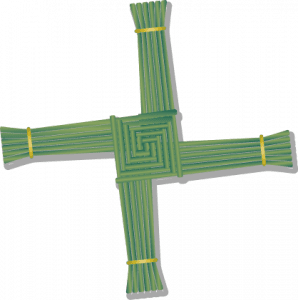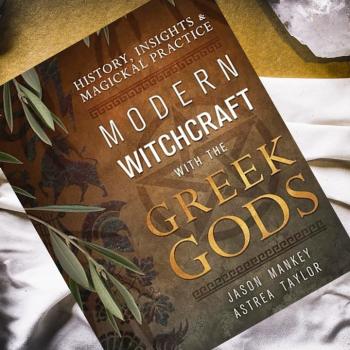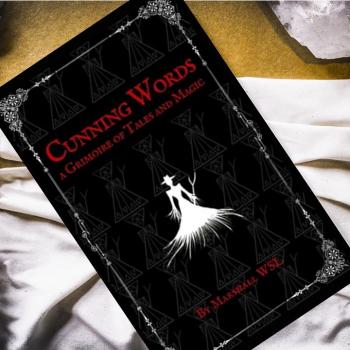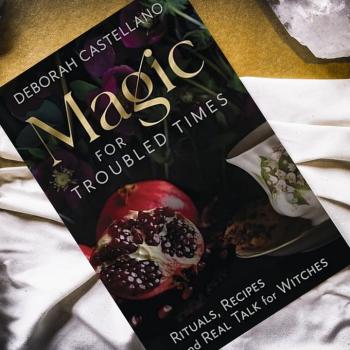This post is part of a new ongoing column, Loop of Brighid, by Christopher Scott Thompson. Look for it on alternate Thursdays!

Brighid is one of the most beloved and widely-venerated deities in the entire world, and the worship or veneration of Brighid in one of Her many forms seems to cross all boundaries of culture, language and religious tradition. Goddess of poetry, smithcraft and healing in ancient Ireland, Brighid is adored less for Her specific characteristics than for the energy of endless compassion, gentleness and creativity with which She has always been associated. According to the ancient Irish text called Cormac’s Glossary, Her worship was so popular in the pagan era that Her name could be used for any goddess.
The implications of this statement are not often considered, but to me it implies that Brighid was seen as much more than just a “goddess of poetry” or a “goddess of healing” or even an “Irish goddess.” I think She was seen as all those things, but also as something much vaster and more all-encompassing, a feminine concept of the divine in the broadest possible sense.
Not everyone would choose to interpret Her that way, but the fact remains that Brighid inspires intense devotion even today, although Her worship is usually embedded within other religious traditions rather than organized as a distinct tradition of its own. The most popular form of modern Brigidine devotion is probably “flamekeeping,” in which devotees take turns tending a candle for Brighid on a twenty-day cycle. The largest flamekeeping organization is the Ord Brighideach, which welcomes both Christians and pagans, men and women. Smaller flamekeeping groups or “cills” may restrict membership to women only, or to pagans only. As far as I know, no such organization is restricted to Christians only or men only.
Here are some of the “flavors” of Brigidine veneration.
- Celtic Christian: The veneration of St. Brigid of Kildare within the Catholic, Orthodox and sometimes even Protestant faith traditions. Many Celtic scholars believe that the order of nuns who tended the eternal flame at Kildare in medieval times was derived from an earlier order of priestesses devoted to the goddess. Some Christian Brigidines, such as the nuns who tend the revived flame at Kildare, have been friendly and open to those who view Her as a goddess. Others insist on a clear distinction between the goddess and the saint.
- Celtic Spirituality: Some people embrace both the pre-Christian mythological heritage of Celtic culture and a broad New Age interpretation of Celtic Christianity, without identifying specifically as either pagan or Christian. These people usually see the legend of St. Brigid as being derived from the earlier lore of the goddess Brighid.
- Goddess Movement: Devotees of Brighid who identify with feminist spirituality or the Goddess Movement. Followers of this movement worship a more-or-less monotheistic Goddess with many different names and aspects, including Brighid.
- Wiccan: Some Wiccans identify Brighid with the Wiccan goddess, usually in Her “maiden” form. Those who consider themselves “Celtic Wiccans” may be very focused on Brighid, while others may see Her as only one of their goddess’s many forms.
- Reconstructionist: Celtic Reconstructionists attempt to accurately reconstruct the religion of the Iron Age Celts. Brigidine devotion within Celtic Reconstructionism puts a high priority on the historical accuracy of current practices.
- Traditionalist: Groups that try to practice Gaelic folk traditions in a Gaelic cultural and religious context, including the veneration of Brighid as a saint or goddess. Some groups with Traditionalist roots now refer to their practice as Tribal Polytheism or Sinnsireachd, a word mean “ancestral ways.”
- Neodruidic: Groups practicing Druidry can range from being virtually Reconstructionist to being virtually New Age, and there are also several older British orders based on the 18th century writings of Welsh Romantic Iolo Morganwg. Some Neodruidic organizations include both individual Brigidine devotees as well as temples, groves, orders or flamekeeping groups devoted to Brighid.
- Brigidine Pagan: This is my own term for pagan worship focused primarily on Brighid whether or not the devotee also identifies with Celtic Reconstructionism, Druidry or some other path. Some Brigidine pagans also worship other Celtic gods and goddesses or even non-Celtic deities, while others worship Brighid alone. Some Brigidine pagans think of Brighid as a (not necessarily “the”) creator of the universe or the world, while others think of Her as simply a Celtic goddess they happen to be personally devoted to. Some think of St. Brigid as an avatar of the goddess and some do not. Some think of certain other goddesses such as Brigantia as manifestations of Brighid while others do not.
The defining feature of Brigidine paganism is simply devotion to Brighid as the core of one’s religious and spiritual life. Based on the number of pagans who identify primarily as devotees of Brighid on internet forums and in other contexts, this seems to be a widespread type of pagan worship, but it is not very easy to pin down or categorize. Brigidine paganism varies quite a bit from one devotee to another, so it does not have a strictly-defined theology beyond its emphasis on Her. It is perhaps best understood through the energy of the goddess Herself — an energy of light and fire, of love and healing, of artistic inspiration and of peace and justice.
Brigidine pagans often see Brighid’s tendency to cross boundaries as a defining part of Her nature, and thus place much less emphasis on strict historical reconstruction than on personal devotion. They also tend to be open to the Christian side of the Brigidine tradition even if they don’t identify with Christianity.
I personally have a deep interest in theology, mysticism and ecstatic practices, and I’ll be talking about those subjects frequently in this column. I’ll also talk about historical research quite a bit, but always in service to the devotional path rather than for its own sake. I study the history of Celtic religion in order to better serve Brighid– not the other way around!













